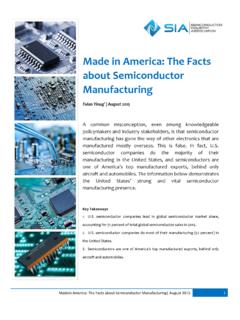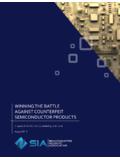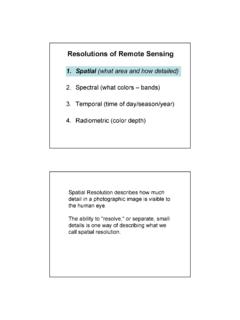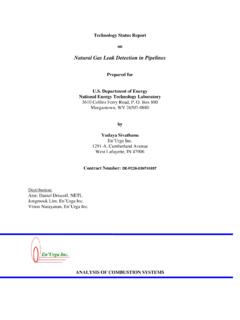Transcription of FROM MICROCHIPS TO MEDICAL DEVICES
1 FROM MICROCHIPS TO MEDICAL DEVICES . SEMICONDUCTORS AS AN ESSENTIAL INDUSTRY DURING THE COVID-19 PANDEMIC. FALL 2020. The Semiconductor Supply Chain is Essential to Pandemic Response & Recovery The COVID-19 pandemic highlighted the importance of information and communication technologies (ICT). in supporting essential activities in a crisis, and the role of an ever- widening range of digitized services, from commerce to education to healthcare, in building a resilient society. It also exposed unique challenges facing the ICT supply chain, however, in which operating restrictions and regulatory barriers in one region create disruptions and shortages throughout the global supply chain. As governments around the world continue to adjust strategies to recover from and respond to the current pandemic, as well as formulate policies to respond to future global public health crises, it is critical policymakers maintain open and connected supply chains of essential goods including semiconductors as part of their crisis-response strategies.
2 By recognizing and specifying ICT. components like semiconductors as essential infrastructure, . policymakers can avoid shortages and disruptions of ICT components that go into other essential goods needed for MEDICAL care, food distribution, remote work, and infrastructure. This paper outlines the many ways both obvious and non-obvious that semiconductors are supporting governments' responses to the COVID-19 pandemic; lessons learned from the pandemic's impact on the semiconductor supply chain; and some immediate steps policymakers can take to maintain production and shipments of essential ICT goods in preparation for future public health crises. 2 | SEMICONDUCTOR INDUSTRY ASSOCIATION. I. Semiconductors as Essential in Public Health Crises Semiconductors are the brains of electronic DEVICES crucial to pandemic response and recovery of the global economy. They provide user input, display, wireless connectivity, processing, storage, power management, and other essential functions to a wide array of essential products, life-saving equipment and critical infrastructure.
3 This includes healthcare and MEDICAL DEVICES , telecommunications, energy, finance, transportation, agriculture, manufacturing, aerospace and defense. Semiconductors also underpin the IT systems that make remote work possible and provide access to essential services across every domain, including medicine, finance, education, government, food distribution, and more. Throughout this global pandemic, semiconductor-rich DEVICES have become increasingly prevalent in developing solutions for numerous problems in the economic and public health sphere. The ability of semiconductors to drive performance in these critical sectors is tied to Moore's Law, the observation that the capabilities of semiconductor chips will double roughly every two years, while the price goes down. As of 2019, the most advanced microprocessors contain nearly 40 billion To put this into perspective, Dan Hutcheson of VLSI. Research has underscored this feat by noting the capability needed to make today's chips are a tenth or smaller than the size of the coronavirus.
4 The following section highlights just a handful of ways in which the semiconductor industry is essential to life-saving equipment and critical infrastructure needed to battle the global pandemic. A. MEDICAL DEVICES Semiconductors are an integral component of many MEDICAL DEVICES used in hospitals and doctors' offices today, including many DEVICES that are critical to treating COVID-19 patients, as displayed in the chart below. Any MEDICAL device that can be plugged into an electric socket or has batteries depends on semicondutors to operate. Semiconductors provide functions such as operations control, data processing and storage, input and output management, sensing, wireless connectivity and power management. By enabling functions previously performed by non-semiconductor DEVICES , semiconductors have often lowered costs and improved performance at the same time. This has proved critical to the COVID-19 response and improving health care in general. Two specific examples of semiconductors in MEDICAL DEVICES are below: 1.
5 Portable Ultrasound DEVICES -- In a hospital setting, the first line of detection for COVID-19. is identifying recognizable symptoms of the virus such as lung lesions. Quickly identifying this trait of the severe acute pneumonia associated with the virus allows doctors to treat afflicted patients without having to wait for tests on viral infection. This rapid response is possible with handheld ultrasound DEVICES and temperature screening. In mid-February, 1. IC Insights, Inc. the McClean Report 2020, Page 14. 3 | SEMICONDUCTOR INDUSTRY ASSOCIATION. Chinese physicians detailed the importance of ultrasound imaging of the extent of damage to a patient's lungs and other internal organs in the rapid diagnosis, treatment and efficacy evaluation of severe acute pneumonia. 2 These portable ultrasound DEVICES have transitioned from utilizing piezoelectric crystals to semiconductor chips, greatly reducing the cost and improving Now, due to the utilization of semiconductors, hospitals have access to vastly more affordable and efficient technologies to assess internal injuries in patients.
6 2. Ventilators -- Ventilators are utilized to treat patients with severe lung damage by assisting breathing and are controlled by semiconductor chips. The ventilator system uses semiconductor sensors and processors to monitor vital signals, determine the rate, volume, and amount of oxygen per breath, and accurately adjust oxygen levels according to the needs of the patient. These signals are read and interpreted by the machine's semiconductor processers, which control the speed of the motor that translates to mechanized breathing to support a Exhibit 1: Examples of MEDICAL DEVICES that Rely on Semiconductor Technology MEDICAL Device End-Market for Semiconductors In 2019, the MEDICAL end use market accounted for $ billion in total semiconductor sales, roughly 11% of the global industrial semiconductor market, and of the total semiconductor market. The MEDICAL semiconductor segment is growing faster than the overall industrial semiconductor market, driven by long-term trends such as the aging population, the rise of telehealth, the move to portable and wearable DEVICES , and the rise of artificial intelligence.
7 (Source: OMDIA). 2. 3. 4. 4 | SEMICONDUCTOR INDUSTRY ASSOCIATION. B. Public Testing and Tracing Accurate and timely testing for COVID-19 is a vital part of assessing risk and determining treatment needs for the public, and semiconductor enabled MEDICAL instruments show promise for advancing testing efforts. Testing for COVID-19 has several different fronts, including analysis of biological information and identifying symptoms of severe cases. Reducing the rate of transmission is key for reopening strategies, and there are a variety of methods to test and monitor populations without significant invasions of privacy. Temperature screening is highly beneficial for any workplace hoping to reopen their spaces to larger amounts of employees. A. quick temperature scan upon entry can determine if someone is feverish and guide leaders in preventing transmission of any sickness. This can be done through thermal cameras or non- contact forehead infrared thermometers and has been part of several re-opening One semiconductor company has been hired to manufacture chips for a temperature monitoring skin-patch that synchronizes with mobile applications to help assess early COVID-19 signs.
8 This patch is designed to be compatible with digital tracing efforts that are being spearheaded by companies like Google and C. Accelerating Vaccine Development The pandemic has rapidly generated data researchers can use to develop a COVID-19 vaccine, but the sheer volume of this data makes it difficult for scientists to find the specific data they need. During the 2003 SARS outbreak, only 7% of scientific articles addressing epidemiological research into the disease were published during the height of the Today, cutting- edge technologies are streamlining the research process for present-day developers. For example, an engineer from a semiconductor company has develop a platform called Deep Search, which uses natural language processing to mark-up research papers for more accurate discovery by search engines. So far, this platform has 460 active users and nearly 46,000. processed scientific In addition to individual technologists, cooperative research organizations maximize development capacity by leveraging economies of scale.
9 The COVID-19 High-Performance Computing (HPC) Consortium is a cooperative network designed to join the computing capacities and data collection of groups including industry, academia, federal agencies, and international government Early in the pandemic, a semiconductor member of this consortium deployed its AI technology to help universities, companies, and clinics lower the time required to model and run different potential treatments from weeks to minutes. This significantly saved time and resources needed to develop hypothetical solutions in wetlabs. With so many institutions using its technology, the company also created a mutually reenforcing network effect with the data generated by each client 5. 6. 7. 8. wave-of-coronavirus-research 9. 10. 5 | SEMICONDUCTOR INDUSTRY ASSOCIATION. D. remote Healthcare and Vulnerable Populations A critical aspect of safely reopening economic sectors is protecting vulnerable populations such as the elderly, diabetic, and hearing impaired.
10 Managing contact with these populations is the first step, but real-time monitoring systems allow physicians access to information regarding the daily status of their patients both in house and remotely. Semiconductors play an important role in this. remote healthcare, or telemedicine, is necessary and highly beneficial during the COVID-19. crisis, and semiconductors are vital to IT infrastructure and to wearable MEDICAL technology for patient monitoring. This technology is especially helpful to the elderly population and patients with underlying health conditions. Prior to the coronavirus outbreak, issues already existed in treating immobile patients in remote locations such as nursing homes. People with diabetes are also at higher risk from the coronavirus. This risk can be mitigated with new technologies that make use of advanced sensors such as continuous glucose monitoring (CGM) and wearable insulin CGM works by placing a sensor on your skin which transmits information to a device that will alert you if your blood sugar fluctuates greatly.
















